By Sheila Doucet, AAWE Paris, with help from Yolanda Henry, FAUSA
hydroponics (n): “process of growing plants without soil,” 1937, formed in English from hydro- “water” + “ponics,” from the Greek ponein “to labor.”
Source: Online Eytmology Dictionary
As was so eloquently explained in last May’s Global Issues Digest article featuring our current environment target project “Awesome Blossoms,” hydroponics is a fascinating principle whose time has come. Not all communities – regardless of whether they are in Kenya, the United States or other urban communities across the globe – have easy access to nutritious, fresh fruits and vegetables. Hydroponic systems allow communities to overcome certain constraints – for instance, as an alternative to growing crops in polluted soils, creating food availability in small spaces, or increasing crop yields in climates where multiple harvests are not possible. The Environment Team decided to delve further into the topic to see how other groups are applying these basic principles – sometimes in our own backyards.
Hydroponic vegetables...in a supermarket near you!
First, a word from Canada. St. David’s Hydroponics is located just a few miles from Yolanda’s home in Niagara-on-the-Lake, Ontario, Canada. Amidst vineyards and orchards, there are 84 acres of bell peppers, 1 acre of hot peppers and 16 acres of eggplants in two massive greenhouses. Their website explains how they sustainably grow the produce, which is shipped all across eastern North America. Yolanda is able to find their peppers both in her local supermarket and also when she is shopping for groceries in Florida. Next time you’re at a grocery store in the eastern US, check the stickers to see where the peppers and eggplants are grown! Who’d have thought they’d be coming down from the north? And they are not just growing food!
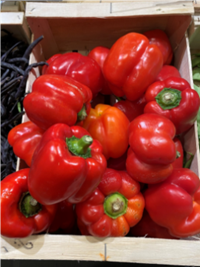
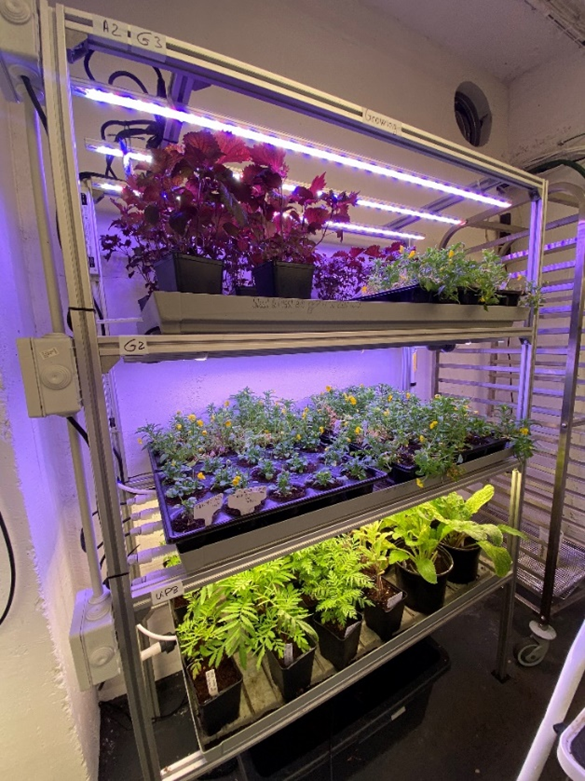
You may be surprised to learn that a repurposed underground parking lot located within the Paris city limits hosts several start-ups, a handful of which have adopted hydroponics to grow their fresh produce. They typically raise food crops such as a range of lettuces and mushrooms as well as endive. However, one innovator, Superette, has chosen to focus on supplying restaurants and bars with a choice of up to fifty aromatic herbs and edible flowers ranging from absinthe, red sorrel and mountain mint to blue giant hyssop, pansies and the delicate purple oxalis. The team starts every plant from seed and adapts the water flow, light, minerals and ventilation to the needs of each variety. The next time you’re eating out and your eyes are regaled with a colorful flower garnish, it may have been grown hydroponically underground.
Additional applications for the climate: two vertical hydroponic garden examples in Paris
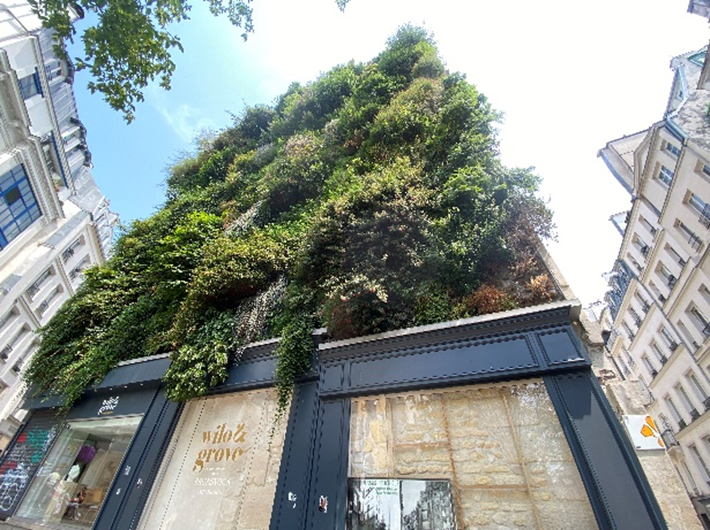
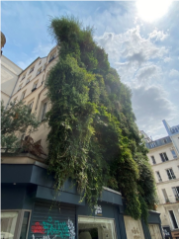
“L’Oasis d’Aboukir,” Patrick Blanc, 83, rue Aboukir (Paris)
Hydroponics principles are not limited to agricultural purposes. Landscape architect Stanley Hart White was awarded a patent in 1938 for his first-of-a-kind botanical blocks or “Vegetation-Bearing Architectonic Structure and System.” It is essentially a system where plants are planted in blocks, attached to a wall and watered via a self-contained irrigation system. The photos above show one of French botanist Patrick Blanc’s designs, which he popularized in the 1980s. This Parisian example integrates a basic hydroponic principle: roots receiving nutrients and water via a recycled solution. There are over 7,000 plants and over 200 species in this urban green forest — all on one building façade. In this case, the plants are attached to a felt and PVC (plastic) mesh which is itself attached to a structure, thereby protecting the building’s façade from penetrating root systems.
Blanc was inspired by how, in the natural world, plants cling to even the smallest of crags. The effect is both stunning and practical, due to the plants’ ability to counteract the seasonal extremes of both hot and cold ambient temperatures by providing thermic insulation for the building. To learn more, read a brief overview of the history of Green Walls. And remember, Green Wall Day is February 15, in commemoration of Stanley Hart White’s birthday.
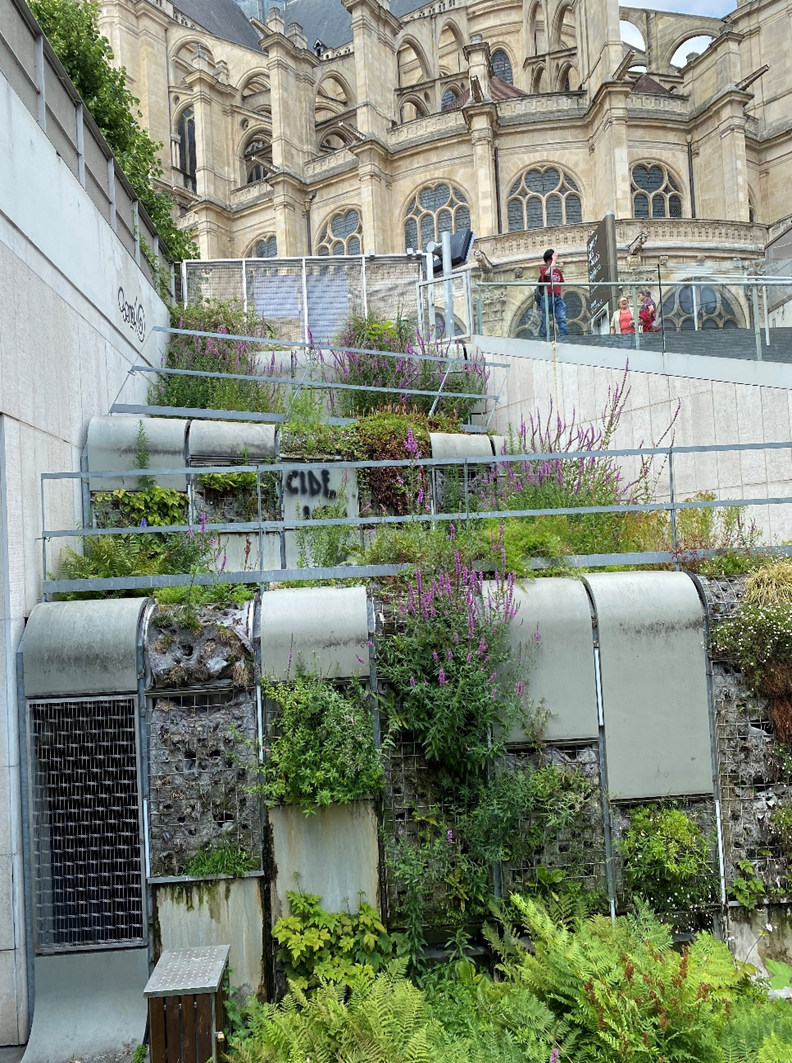
Les Halles near St. Eustache Church (Paris, 75001)
Scorching heat. Heat advisory warnings. Unprecedented higher temperatures. It seems as if every summer, the “highest temperatures ever recorded” are broken across the Northern Hemisphere in July and August. We are becoming more acquainted with terms such as “heat bulbs” and “heat islands.” Wikipedia defines an urban heat island (UHI) as “an area that is significantly warmer than its surrounding rural area due to human activities.” It happens because concrete buildings, sidewalks and asphalt roads absorb or retain heat. In Paris, this effect is compounded by an additional signature architectural feature – dark roofs which also absorb heat. What were previously sterile, heat-absorbing spaces are being reimagined by urban planners to mitigate against the dangers of the UHI effect, as plants are known to increase air quality and decrease ambient temperatures. Will we begin to see more of these modern hydroponic adaptations of the Hanging Gardens of Babylon in the future?
To conclude, hydroponic principles can be adopted to a wide variety of settings and for a variety of different reasons. The examples included here are only a quick introduction. There may be applications in your own community! Although it is a helpful technique, as with any system, it too has technical limitations which vary with any particular system’s design. We are reminded that there is no magical, “one size fits all” solution to tackle climate change. However, if we keep an open mind and adaptive attitude, the possibilities are only limited by one’s imagination.
Sources and further information:
Green Walls
- “Going Vertical: The History of Green Walls,” LAND8 Landscape Architects Network, January 19, 2014
- “Green Walls May Cut Pollution in Cities,” National Geographic, published March 27, 2013
- “Happy 131st Birthday Stanley Hart White, the inventor of the living wall,” Pritchard & Pritchard, published February 7, 2022.
- Website of French Botanist and Designer Patrick Blanc who popularized “Living Walls”
- “Solving The Urban Agriculture Puzzle,” Thea-Isabella Otto for Association of Vertical Farming, published August 1, 2023
- “12 Pros & Cons of Hydroponic Farming,” by Nicole McCray for Earth.org, published February 12, 2023
Our sincere thanks to Yolanda Henry (FAUSA) for her contribution from Canada.
All photos by the author, Sheila Doucet

